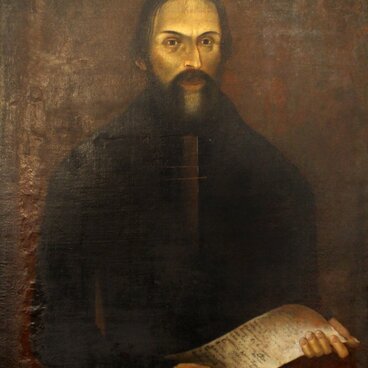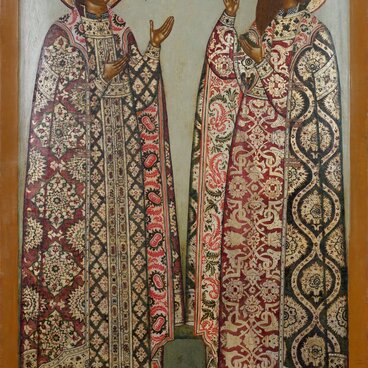The cloak depicting Saint Paisius of Uglich, the organizer of the Intercession Monastery, is of great interest. The Monastery was established in 1461 during the reign of Grand Prince Vasily Vasilyevich the Blind and was finally organized by Saint Paisius under Andrey Vasilyevich Bolshoy, the Prince of Uglich.
From that moment on, the monastery received a special status: apart from being recognized as the center of the principality’s religious life by contemporaries, the Intercession Monastery also embodied the political ambitions of Andrey Bolshoy, the appanage prince of Uglich. It was at his request that the young austere and devout Paisius — the nephew, student, and favorite penitent of Saint Macarius — went to Uglich because he was destined for great and distinguished service. Later, Saint Paisius became the confessarius and councilor of Andrey Bolshoy, and when the prince fell out of favor with Ivan III, Paisius interceded on behalf of his prince in front of the Grand Prince of Moscow.
The general composition of the icon is determined by the ideas of humility, holiness, and selfless service to God, which is indicated in the depiction of the saint who stands praying in a calm and humble manner. This cloak is dated to the second half of the 17th century, but it was made in keeping with the best traditions of the 16th century. The main means of artistic expression is the use of silk of local colors. The image of the saint is canonical. The monumental figure with slightly elongated proportions is painted using smooth and broad lines. The relatively small feet barely touch the ground and are almost completely hidden by the clothes, adding a certain lightness to the large figure. The background is greenish silk completely covered with a floral pattern in the shape of vines and large stylized leaves, depicted using woven gold and silver “on figured silk velvet”. The halo is made using gold embroidery.
The saint’s expressive face, high forehead, thin arches of the eyebrows, and large eyes turned to heaven in prayer — all of this demonstrates that Saint Paisius of Uglich was a great devotee and prayed to God for the entire humanity.
From that moment on, the monastery received a special status: apart from being recognized as the center of the principality’s religious life by contemporaries, the Intercession Monastery also embodied the political ambitions of Andrey Bolshoy, the appanage prince of Uglich. It was at his request that the young austere and devout Paisius — the nephew, student, and favorite penitent of Saint Macarius — went to Uglich because he was destined for great and distinguished service. Later, Saint Paisius became the confessarius and councilor of Andrey Bolshoy, and when the prince fell out of favor with Ivan III, Paisius interceded on behalf of his prince in front of the Grand Prince of Moscow.
The general composition of the icon is determined by the ideas of humility, holiness, and selfless service to God, which is indicated in the depiction of the saint who stands praying in a calm and humble manner. This cloak is dated to the second half of the 17th century, but it was made in keeping with the best traditions of the 16th century. The main means of artistic expression is the use of silk of local colors. The image of the saint is canonical. The monumental figure with slightly elongated proportions is painted using smooth and broad lines. The relatively small feet barely touch the ground and are almost completely hidden by the clothes, adding a certain lightness to the large figure. The background is greenish silk completely covered with a floral pattern in the shape of vines and large stylized leaves, depicted using woven gold and silver “on figured silk velvet”. The halo is made using gold embroidery.
The saint’s expressive face, high forehead, thin arches of the eyebrows, and large eyes turned to heaven in prayer — all of this demonstrates that Saint Paisius of Uglich was a great devotee and prayed to God for the entire humanity.


